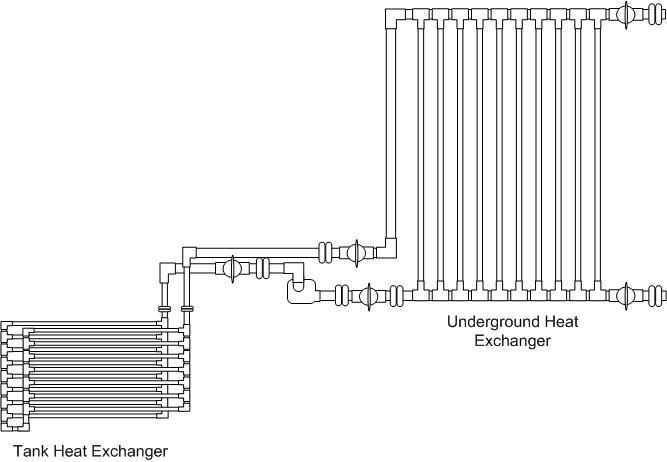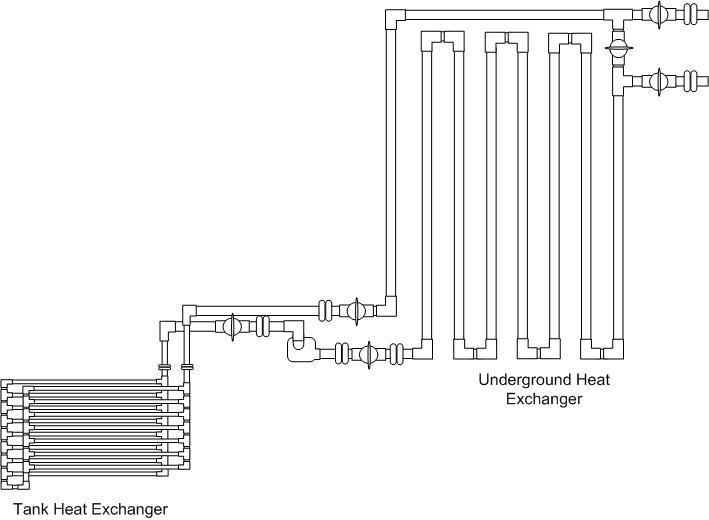


|
 |
|
|
#1 |
|
Registered Member
Join Date: Jan 2006
Location: Naperville, IL
Posts: 2,911
|
Geothermal Cooling Closed Loop Designs
I'm thinking of constructing a geothermal cooling closed loop and was wondering if anyone could point me in the direction of a good design guide?
I've done some google searches and haven't really hit on any thing much more thorough than some concept ideas. I am thinking of putting it in my crawlspace and would like to minimize the amount of digging to just what is necessary. I'm thinking that I shouldn't need to go more than 6-8" deep as crawl area seems to stay fairly cool all year round. Any ideas on what material, diameter, length, depth would work best to be able to create a 5-8 degree drop on a 150 gallons assuming the soil temp is around 60 degrees? (I need to actually measure the temp) Thanks! Last edited by ppurcell; 06/07/2007 at 07:52 PM. |
|
|

|
|
|
#2 |
|
Registered Member
Join Date: Jan 2006
Location: Naperville, IL
Posts: 2,911
|
I am thinking of something along these lines. I think the second design will probably produce better results than the first because I don't the the waterflow will be uniform through the first design.
How do I figure out heat transfer rates and what my expected flow rate through the piping will be with any particular pump? Can I use the Head-Loss calculator to figure that part out?  
Last edited by ppurcell; 06/08/2007 at 01:24 PM. |
|
|

|
|
|
#3 |
|
Registered Member
Join Date: Jan 2006
Location: Naperville, IL
Posts: 2,911
|
Thermal Transfer Calculations
I did some searching around looking for formulas to calculate heat transfer on PVC and from these two links I found two formulas that seem to apply.
http://www.engineeringtoolbox.com/co...fer-d_428.html http://geoheat.oit.edu/bulletin/bull22-3/art2.pdf http://www.gizmology.net/pipe.htm I found the following formula (from the first link) to calculate heat transfer and used the conductivity for PVC: q = k A dT / s (1) where: q = heat transferred per unit time (W, Btu/hr) A = heat transfer area (m2, ft2) k = thermal conductivity of the material (W/m.K or W/m.oC, Btu/(hr oF ft2/ft)) dT = Temperature difference across the material (K or oC, oF) s = material thickness (m, ft) I am planning on using 100' thinwall PVC. So I get this formula (I estimated the wall thickness based on sch40 and sch80): Pipe diam inches: 1 k for PVC: 0.19 Pipe Diam: 1.315 Length feet: 100 Area sq. ft: 2.87 Temp Diff: 15 thickness: 0.11 Heat loss BTU/hr: 74.33 Then I used another formula (from the second link) to calculate maximum flow rate to bring the water temp inside the pipe to the temperature of the sand/soil around the underground heat transfer element: d = q / (500 V) where: d=final temperature q=heat transferred per unit time V=water velocity in gallons per minute Ground Temp: 66 Starting Water Temp: 81 btu loss /hr: 74.33 gph flow rate: 1 Temp Drop: 8.9 Final Water Temp: 72.1 So, are there any engineers out there that are willing to look at this and tell me if I'm even in the right neighborhood? Last edited by ppurcell; 06/08/2007 at 04:31 PM. |
|
|

|
|
|
#4 |
|
Registered Member
Join Date: Sep 2005
Location: Hollywood Florida
Posts: 3,633
|
just buy some pex flex hose of as much footage as you want to buy and put it in the ground
|
|
|

|
|
|
#5 |
|
Premium Member
 Join Date: Aug 2003
Location: Redmond, WA
Posts: 493
|
Pex is probably the best bet.
I buried 250' of pex in the trenches for my sprinkler system, another 100' of pex in the crawlspace. Ground temp looks to be 55F-60F right now. In my sump, I have 10 pieces of 1/2" titanium tubing (each is 12" long) with masterkleer pvc tubing connecting it all in series. Use an iwaki20rz to pump the water. All the water goes in one continuous loop. Only tee is to a vertical 6' piece of tubing right at the pump intake - that allows bubbles to escape and provides a means of topping off. Looks like it's about a negative 550w heat transfer. Confirmed this by measuring 20gal temp drop from 80.9 to 78.2 in 15min and also by using 650w of heaters to counteract the cooling. Your mileage my vary. The ground here in Seattle area is heavy moist clay and it never gets hot down where the sprinkler pipes are buried. BTW. I have a 1/3HP chiller in the crawl. But I added this loop because for 50w of electricity, it's -550w of cooling. The chller is -1200w of cooling, but it's about 650w of electricty. If you can do it, I'd recommend it. |
|
|

|
|
|
#6 |
|
Registered Member
Join Date: Jan 2006
Location: Naperville, IL
Posts: 2,911
|
Thanks for the suggestion. I was out of town when you replied and then forgot that I needed to reply for a couple of days...
PEX is kind of pricey compared to thinwall PVC (about $1/ft compared to $.15 foot if I remember), but it would be easier to work with if I don't have to use fittings which require the special PEX tools to install. And the PEX cost might be partially offset by not buying all of the PVC fittings. I don't think I can use my crawlspace to any great advantage. There is a moisture barrier at about 15" and there is course gravel (1/2") above and fine gravel (1/4") below. I dug down to about 24" and didn't find soil so I am going to assume that I am going to have to put the exchanger outside. Can you tell me where you got the titanium tubing and a more detailed explanation of how you figured out the 550w heat transfer? I'm not comprehending your test.... I'm a little slow. |
|
|

|
|
|
#7 |
|
Premium Member
 Join Date: Aug 2003
Location: Redmond, WA
Posts: 493
|
PEX has higher rate of thermal transfer than thin wall PVC. I use plastic compression pex fittings from home depot. Ordered 300' roll of pex online because it was cheaper even with shipping than at home depot.
I got the titanium tubing on ebay. Scrap is fairly cheap and you end up with a bunch of misc lengths all under 3'. I ordered 6 pieces and cut it up with a pipe cutter. The 550w of heat transfer is done with a little math. It takes 1kilocalarie to heat 1kg of water by 1C. And a kilocalarie is 1.16 watt-hours. So 20gal is roughly 80kg of water. And 2.7F in 15 min is about 1.5C in 15min or 6C in an hour. So 80kg * 6C * 1.16 = 556 watts. After 15min, I added 650 watts of heaters to the 20gal of water and observed the temp rising slowly. I repeated the math based on another 15min and computed 80watts based on that change in temp. So that confirms that 650 watts of heater was only putting in roughly 80watts into the water, so roughly 570watts must be going into the loop (or into mislabeling of the heaters). You need to get your exchanger buried in dense moist soil. Otherwise it just isn't gonna help much. Good luck. As I've been running it more, it looks like over the long term (all day) I'm only getting about 250-300watts of heat transfer. I think this is because I'm heating the soil around the pex above the natural 55-60F. |
|
|

|
 |
|
|